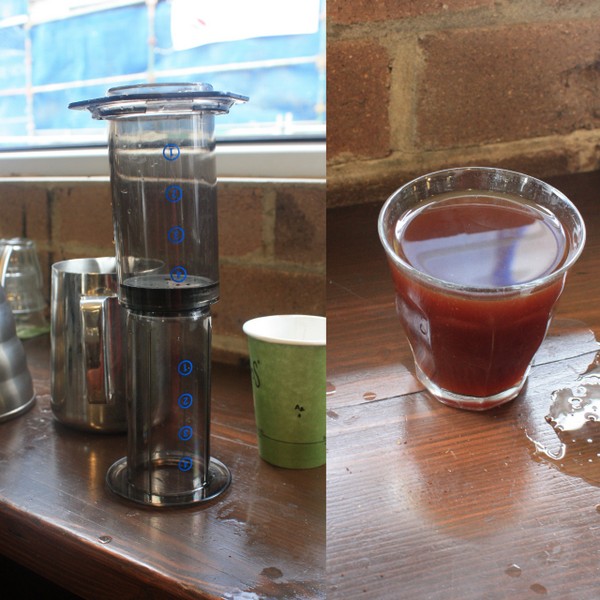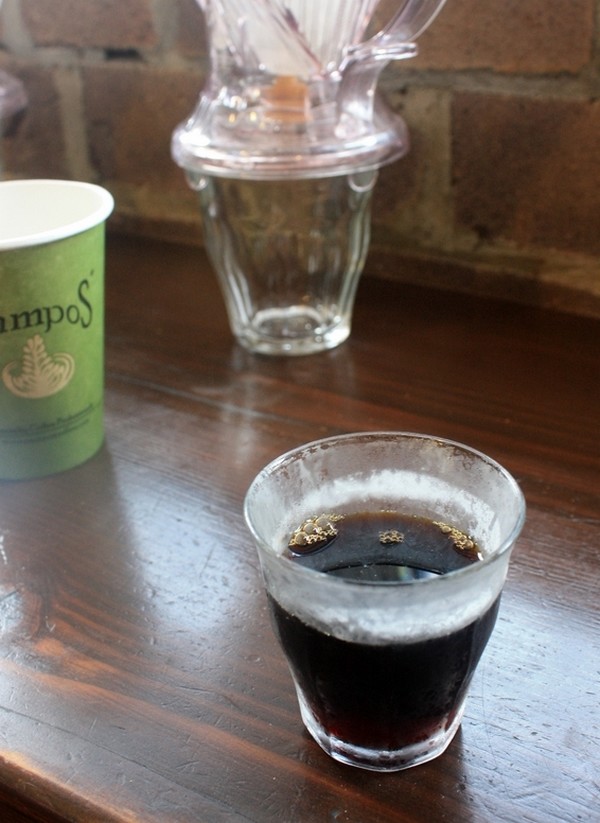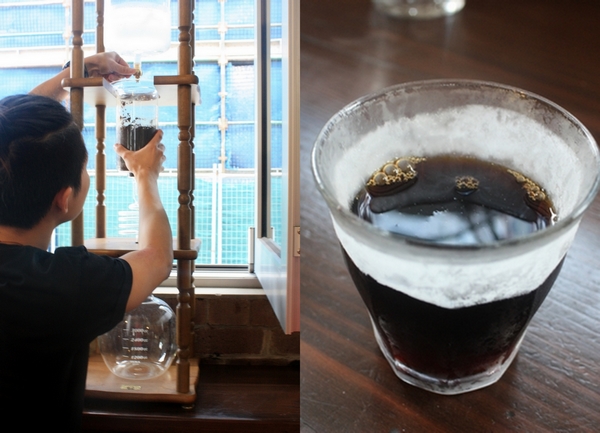In these posts, we look at black coffee – the contraptions, the methods, the how to’s and the why’s. David Ruslie, Campos’ resident black coffee obsessive, walks us through aeropress, cold drip and pourover. He says there’s a growing interest in black coffee, because, sans milk and sugar, it really allows you to explore the flavour profiles of the coffees themselves.
“Coffee appreciation…it’s catching up to wine appreciation. There’s a lot more tasting notes, say with wine you have 200 tasting notes. Well, with coffee, you have 800 tasting notes, it’s really incredible.” David says. Sure, the man or woman on the street doesn’t need to know all 800 to enjoy their ‘new brew’, but it’s handy, he says, to be able to identify which flavours you prefer. You may think you’re not a black coffee drinker, but maybe you just haven’t found the right bean or the right method.
This week David shows us the simplest and most portable of the black coffee methods, aeropress. There are two main ways David uses the aeropress: the ‘normal’ method and the inverted method. In both cases, he advises that you pre-wet the paper filter with a few drops of water beforehand. To be precise, it’s also worth having a digital scale on hand to weigh your coffee and water, but you can also do it by sight. And the reason the water is boiled at the very beginning is that we’re aiming for water temperature of 92-96 degrees. The video gives you a good idea of what the below instructions actually look like in practice. If you’re interested in buying an aeropress, follow this link.
What you need:
– An aeropress
– an aeropress paper filter
– a kettle
– a mug to drink out of
– ground coffee or coffee beans
– a hand grinder (optional)
– a digital scale (optional)
embedded by Embedded Video
YouTube
The Normal Method
1. Boil your kettle.
2. Dampen the paper filter, place it in the aeropress disc and fit the disc into the larger of the two tubes.
3. Place the aeropress, filter end down on your scales and ‘zero’ them. Grind and/or pour in coffee to the desired weight.
4. Place aeropress over a mug or jug, filter side down.
5. Zero your scales again. Pour in 200g of boiled water. Give it a stir. Steep for 45 seconds.
6. Stir once again and place the ‘plunger’ in the aeropress. Slowly push down until all coffee is in the cup (about 20 seconds).
The Inversion/Upside Down Method
1. Boil your kettle.
2. Push the ‘plunger’ into the aeropress tube and turn upside down so that the tube is on top and the plunger is on the bottom.
3. Place it on your digital scales and ‘zero’ them. Grind and/or pour in coffee to the desired weight into the tube.
4. Zero your scales again. Pour in 200g of boiled water. Do not stir. Dampen the paper filter, place it in the aeropress disc and place on top of the upside down aeropress. Steep for 1 minute and 30 seconds.
5. Stir the coffee to break the crust. Fit the disc into the top of the aeropress. Place a jug or mug upside down on it.
6. Flip the entire aeropress 100 degrees. Slowly push down until all coffee is in the cup or jug (about 20 seconds).
Other Black Coffee Revolution Posts:
Cold Drip Coffee
Over the next month, I look at black coffee – the contraptions, the methods, the how to’s and the why’s. David Ruslie, Campos’ resident black coffee obsessive, walks us through aeropress, cold drip and pourover and explains why he’s so passionate about this back-to-basics approach.
“Australian coffee culture is actually milk coffee culture, and I’m trying to change it,” David tells me. Single-handedly trying to convert us from flat-whites-with-one to siphon/cold drip/aeropress? Not so much, Dave says, but he’s excited to share the precision and hands-on nature of black coffee brewing with me. He kindly offered to walk me through these ‘third wave’ or ‘fourth wave’ (whatever it is we’re up to now) methods. We’re going to start with the chemistry lab setup that is cold drip.
David explains that there are two basic methods of coffee making- immersion and percolation, and cold drip is full percolation. This method involves steeping fresh, coarse coffee grounds at room temperature over time, usually around 12 hours. This results in an extremely caffeinated, low acidity, sweet-tasting cold coffee, and a brew that non-espresso drinkers often warm to. ‘It doesn’t actually taste like coffee.’ says David, which is a good way of explaining the flavour- bright, mild and tea-like.
For the cold drip, David used 1500mls of water for 250g of ground coffee, with a resulting yield of 1200ml of cold drip brew. The ideal brewing time is 12-15 hours, as there is no heat to aid extraction. David favours 8-9 drips per 10 seconds
As complex as this chemistry lab setup may look, you don’t necessarily need it to cold brew your own coffee at home. Similar results can be achieved by steeping coffee in a jar or overnight, and then pouring the resulting liquid through a coffee filter and chilling for future use. You can also do this in a French press, as you would for hot coffee but again, overnight.
embedded by Embedded Video
YouTube
The video above demonstrates how cold drip is made. For more info on how to brew you own cold coffee at home, click here.
Are you a cold coffee fan? What’s your fave way to enjoy it?
Other Black Coffee Revolution Posts:
Aeropress
About me
 Sharing easy recipes, hunting down the best coffee. Honest accounts, nothing too serious. Read more...
Sharing easy recipes, hunting down the best coffee. Honest accounts, nothing too serious. Read more...Recent Posts
- Aerpress means no more shit #travelcoffee and #workcoffee
- Why I write and four ace bloggers who do it better
- The five best things I ate in London
- Shoreditch is awesome, airports are not
- I quit sugar? Do I bollocks.
- Cubao Street Food, Alexandria
- The Reformatory Caffeine Lab, Surry Hills
- Brewtown Newtown
- Stay caffeinated over Christmas
- Gumption by Coffee Alchemy, Sydney CBD
Popular posts this month…
 The quest for Mex part 2 – Feisty Chicken Burritos posted on December 21, 2010
The quest for Mex part 2 – Feisty Chicken Burritos posted on December 21, 2010  Sparkling Long Black posted on May 10, 2011
Sparkling Long Black posted on May 10, 2011 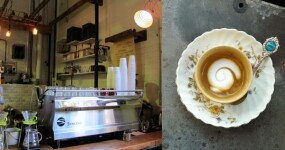 Cubao Street Food, Alexandria posted on May 26, 2014
Cubao Street Food, Alexandria posted on May 26, 2014  2 Chippo Coffee Gems posted on December 1, 2012
2 Chippo Coffee Gems posted on December 1, 2012  Café review – Flint and Steel (Coffee Alchemy), Marrickville posted on March 1, 2011
Café review – Flint and Steel (Coffee Alchemy), Marrickville posted on March 1, 2011 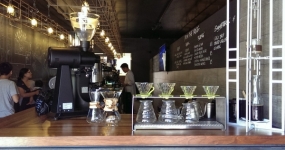 The Reformatory Caffeine Lab, Surry Hills posted on February 14, 2014
The Reformatory Caffeine Lab, Surry Hills posted on February 14, 2014  Review – Philips Saeco Intelia posted on January 10, 2012
Review – Philips Saeco Intelia posted on January 10, 2012  Cheat’s Dulce de Leche posted on January 7, 2011
Cheat’s Dulce de Leche posted on January 7, 2011
Disclaimer:
All opinions in this blog are mine, an everyday, real-life person. I do not accept payment for reviews and nor do I write sponsored posts. I do not endorse the content of the comments herein.

